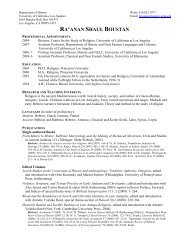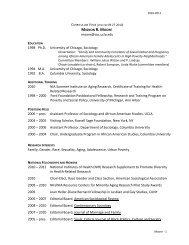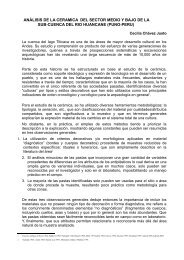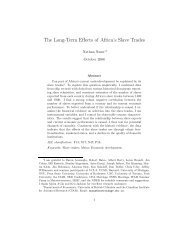EOP Historical Tables of the U.S. Budget - Social Sciences Division
EOP Historical Tables of the U.S. Budget - Social Sciences Division
EOP Historical Tables of the U.S. Budget - Social Sciences Division
You also want an ePaper? Increase the reach of your titles
YUMPU automatically turns print PDFs into web optimized ePapers that Google loves.
6 THE BUDGET FOR FISCAL YEAR 1998, HISTORICAL TABLES<br />
totals. For example, Federal spending for<br />
medicaid constitutes a health care program,<br />
but it also constitutes a form <strong>of</strong> income<br />
security benefits. However, <strong>the</strong> spending cannot<br />
be counted in both functions; since <strong>the</strong><br />
main purpose <strong>of</strong> medicaid is to finance <strong>the</strong><br />
health care <strong>of</strong> <strong>the</strong> beneficiaries, this program<br />
is classified in <strong>the</strong> ‘‘health’’ function. Section<br />
3 provides data on budget outlays by function,<br />
while Section 5 provides comparable data<br />
on budget authority.<br />
Notes on Section 4 (Federal Government<br />
Outlays by Agency)<br />
Section 4 displays Federal Government outlays<br />
(on- and <strong>of</strong>f-budget) by agency. Table<br />
4.1 shows <strong>the</strong> dollar amounts <strong>of</strong> such outlays,<br />
and Table 4.2 shows <strong>the</strong> percentage distribution.<br />
The outlays by agency are based on<br />
<strong>the</strong> agency structure currently in effect. For<br />
example, <strong>the</strong> Department <strong>of</strong> Education was<br />
established by legislation enacted in 1979.<br />
However, <strong>the</strong>se data show spending by <strong>the</strong><br />
Department <strong>of</strong> Education in previous years<br />
that consists <strong>of</strong> education spending attributable<br />
to o<strong>the</strong>r agencies in earlier years,<br />
but now attributable to <strong>the</strong> Department <strong>of</strong><br />
Education.<br />
Notes on Section 5 (<strong>Budget</strong> Authority—<br />
On- and Off-<strong>Budget</strong>)<br />
Section 5 provides data on budget authority<br />
(BA). BA is <strong>the</strong> authority provided by law<br />
for agencies to obligate <strong>the</strong> Government to<br />
spend. Table 5.1 shows BA by function and<br />
subfunction, starting with 1976. Table 5.2<br />
provides <strong>the</strong> same information by agency,<br />
and Table 5.3 provides a percentage distribution<br />
<strong>of</strong> BA by agency.<br />
The data in <strong>the</strong>se tables were compiled<br />
using <strong>the</strong> same methods used for <strong>the</strong> budget<br />
historical tables for receipts and outlays (e.g.,<br />
to <strong>the</strong> extent feasible, changes in classification<br />
are reflected retroactively so <strong>the</strong> data show<br />
<strong>the</strong> same stream <strong>of</strong> transactions in <strong>the</strong> same<br />
location for all years). However, BA is heterogeneous<br />
in nature, varying significantly from<br />
one program to ano<strong>the</strong>r. As a result, it<br />
is not additive—ei<strong>the</strong>r across programs or<br />
agencies for a year or, in many cases, for<br />
an agency or program across a series <strong>of</strong><br />
years—in <strong>the</strong> same sense that budget receipts<br />
and budget outlays are additive. The following<br />
are examples <strong>of</strong> different kinds <strong>of</strong> BA and<br />
<strong>the</strong> manner in which <strong>the</strong>re are large<br />
divergences between <strong>the</strong> creation and use<br />
<strong>of</strong> BA.<br />
• BA and outlays for each year may be exactly<br />
<strong>the</strong> same (e.g., interest on <strong>the</strong> public<br />
debt).<br />
• For each year <strong>the</strong> Congress may appropriate<br />
a large quantity <strong>of</strong> BA that will<br />
be spent over a subsequent period <strong>of</strong> years<br />
(e.g., many defense procurement contracts<br />
and major construction programs).<br />
• Some BA (e.g., <strong>the</strong> salaries and expenses<br />
<strong>of</strong> an operating agency) is made available<br />
only for a year and any portion not obligated<br />
during that year lapses (i.e., it<br />
ceases to be available to be obligated).<br />
• Revolving funds may operate spending<br />
programs indefinitely with no new infusion<br />
<strong>of</strong> BA, o<strong>the</strong>r than <strong>the</strong> authority to<br />
spend <strong>of</strong>fsetting collections.<br />
• BA may be enacted with <strong>the</strong> expectation<br />
it is unlikely ever to be used (e.g., standby<br />
borrowing authority).<br />
• All income to a fund (e.g., certain revolving,<br />
special, and trust funds) may be permanently<br />
appropriated as BA; as long as<br />
<strong>the</strong> fund has adequate resources, <strong>the</strong>re is<br />
no fur<strong>the</strong>r relationship between <strong>the</strong> BA<br />
and outlays.<br />
• As a result <strong>of</strong> <strong>the</strong> <strong>Budget</strong> Enforcement Act<br />
<strong>of</strong> 1990, <strong>the</strong> measurement <strong>of</strong> BA changed<br />
in most special and trust funds with legislatively<br />
imposed limitations or benefit formulas<br />
that constrain <strong>the</strong> use <strong>of</strong> BA. Where<br />
previously budget authority was <strong>the</strong> total<br />
income to <strong>the</strong> fund, BA in <strong>the</strong>se funds for<br />
1990 and subsequent years is now an estimate<br />
<strong>of</strong> <strong>the</strong> obligations to be incurred during<br />
<strong>the</strong> fiscal year for benefit payments,<br />
administration and o<strong>the</strong>r expenses <strong>of</strong> <strong>the</strong><br />
fund. In some, but not all, cases it was<br />
possible to adjust BA figures for <strong>the</strong>se<br />
funds for years prior to 1990 to conform<br />
to <strong>the</strong> current concepts.<br />
• Although major changes in <strong>the</strong> way BA<br />
is measured for credit programs (beginning<br />
in 1992) result from <strong>the</strong> <strong>Budget</strong> En-
















